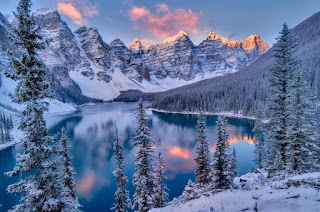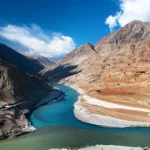
The winter season is a fascinating time of year, with its unique weather patterns and activities. From snow-covered landscapes to holiday traditions, winter brings many unique experiences. As the temperatures drop and the days get shorter, there’s no doubt that winter is here to stay. Whether it’s a winter wonderland or a blizzard, be sure to take the time to enjoy the beauty of winter.
One of the best things about winter is the plethora of activities it offers. From skiing and snowboarding to sledding and snowman building, there’s something for everyone to enjoy. Whether you’re an adrenaline junkie or prefer a leisurely stroll, winter is the perfect time to get out and enjoy the cold weather. If you’re looking for something to do indoors, you can always curl up with a good book and a warm cup of cocoa or get creative with some winter-themed crafts.
Here are 25 interesting facts about Winter:
1. Winter is the coldest season of the year and is characterized by lower temperatures and shorter days.
2. Winter typically starts on December 21st and ends on March 20th in the Northern Hemisphere and June 21st to September 20th in the Southern Hemisphere.
3. In the Northern Hemisphere, snowfall during the winter season is common in some areas, whereas in the Southern Hemisphere, rainfall is usually more common.
4. Winter is the season of holidays, such as Christmas and Hanukkah.
5. The coldest temperature ever measured on Earth was -128.6°F in Antarctica in 1983.
6. The average temperature in the United States during winter is 33°F.
7. In the Northern Hemisphere, the coldest months of the year are usually January and February.
8. Common winter activities include skiing, sledding, ice skating, and snowman building.
9. The longest winter on record was in 1816-1817, when snow covered the entire United States from the Atlantic to the Pacific.
10. During winter, the sun rises later and sets earlier, leading to fewer hours of daylight.
11. Winter is the season of hibernation for many animals, such as bears and groundhogs.
12. The winter solstice marks the shortest day of the year and is usually celebrated on December 21st in the Northern Hemisphere and June 21st in the Southern Hemisphere.
13. The winter months often bring cold and flu season, due to the lower temperatures and less sunlight.
14. The aurora borealis, or Northern Lights, can often be seen in the night sky during the winter months.
15. Common winter sports include ice hockey, curling, and snowboarding.
16. Winter storms, such as blizzards and nor’easters, can bring heavy snow and strong winds.
17. The winter season is the best time to spot constellations in the night sky.
18. Winter is the perfect season to curl up with a good book and a warm cup of cocoa.
19. The winter months are often the driest of the year, with less precipitation than other seasons.
20. The winter season is the perfect time to observe wildlife, as animals are more active in colder weather.
21. During winter, the air is usually drier than other seasons, which can lead to skin and hair issues.
22. The winter season is associated with the holidays, such as Christmas and New Year’s Day.
23. Winter is the perfect time for baking and making winter-themed crafts.
24. In some parts of the world, winter is the rainy season, rather than the dry season.
25. Some animals, such as snow leopards, Arctic hares, and ptarmigans, are adapted to living in the winter season.
Winter is also the season of holidays and celebrations. From Christmas and Hanukkah to New Year’s Day, there’s something for everyone to enjoy. Whether you’re decorating your home or exchanging gifts, the winter season is the perfect time to enjoy the company of your loved ones.
The winter season can also bring some unique wildlife experiences. While some animals hibernate, others are more active in the colder weather. If you’re lucky, you may catch a glimpse of an Arctic hare or a snow leopard. While you’re out and about, be sure to look up in the night sky, as the winter months are the perfect time to spot constellations.
The winter season can also bring some unique weather patterns. From blizzards to nor’easters, winter storms can bring heavy snow and strong winds. On the flip side, the winter months are usually the driest of the year, with less precipitation than other seasons.
Ultimately, winter is a magical season that brings many unique experiences. Whether you’re skiing down a mountain or curled up with a good book, there’s something for everyone to enjoy. So grab your winter coat and get ready to explore the beauty of winter!
5 Frequently Asked Questions about Winter:
- What causes winter?
Winter occurs because of the Earth’s tilt on its axis as it revolves around the sun. Here’s a breakdown:
- Tilt: The Earth is not perfectly upright but tilted at an angle of about 23.5 degrees. This tilt remains constant throughout the year.
- Sunlight distribution: As the Earth orbits the sun, different hemispheres receive varying amounts of direct sunlight.
- Winter hemisphere: During winter, the hemisphere facing away from the sun receives less direct sunlight, resulting in shorter days and colder temperatures. The opposite hemisphere experiences summer.
- Seasonal shift: Every six months, the Earth reaches a point in its orbit where the sun is directly over the equator, causing roughly equal day and night lengths for all latitudes (equinoxes). Then, the tilt takes effect, leading to winter in one hemisphere and summer in the other.
- What are the different types of winter weather?
Winter brings a variety of weather conditions, each with its own characteristics:
- Snow: Frozen precipitation that falls as flakes when water vapor condenses around tiny ice crystals in the atmosphere.
- Sleet: A mix of rain and freezing rain that freezes into small, hard pellets as it falls through colder air.
- Ice: Water that freezes below 0 degrees Celsius (32 degrees Fahrenheit), creating slippery conditions and potential hazards.
- Blizzards: Severe snowstorms with strong winds and blowing snow, reducing visibility and creating dangerous travel conditions.
- Avalanches: Large masses of snow, ice, and debris that rapidly slide down a mountainside, posing a significant threat.
- How do animals adapt to winter?
Animals have developed various strategies to survive the challenges of winter:
- Hibernation: Some animals like bears and groundhogs enter a state of dormancy, lowering their body temperature and metabolic rate to conserve energy while food resources are scarce.
- Migration: Birds and some mammals migrate to warmer regions with more abundant food sources during winter.
- Thick fur or feathers: Many animals grow thicker fur or feathers for better insulation against the cold.
- Food storage: Squirrels and other rodents gather and store nuts and seeds in preparation for winter when food may be limited.
- Physiological changes: Some animals undergo physiological changes like lowering their body temperature slightly to reduce energy expenditure.
- How do people prepare for winter?
People have developed various customs and practices to cope with winter’s challenges:
- Winter clothing: Wearing warm clothes like jackets, hats, gloves, and scarves is essential for staying warm in cold weather.
- Shelter maintenance: Ensuring proper insulation and heating systems in homes and buildings is crucial for maintaining comfortable temperatures.
- Winter sports: Many regions embrace winter with activities like skiing, snowboarding, ice skating, and sledding.
- Winter festivals: Winter brings various cultural celebrations around the world, with traditions like decorating homes, gift-giving, and enjoying special winter foods.
- Stocking up on supplies: People might stock up on food, medicine, and other essentials to prepare for potential winter storms or disruptions.
- What are some safety tips for winter weather?
Winter weather can be dangerous, so it’s important to prioritize safety:
- Stay informed: Check weather forecasts regularly and be aware of potential winter storms or hazardous conditions.
- Travel precautions: Only travel if necessary during winter storms. If you must travel, clear snow and ice from your vehicle, drive cautiously, and be prepared for delays.
- Avoid overexertion: Shoveling snow or strenuous activity in cold weather can increase the risk of heart attack. Be mindful of your limitations and take breaks.
- Dress warmly: Wear layers of warm clothing and ensure proper footwear for traction on ice or snow.
- Hypothermia and frostbite: Be aware of the signs of hypothermia (excessive shivering, confusion, slurred speech) and frostbite (loss of feeling and color in skin). Seek medical attention immediately if you suspect either.









